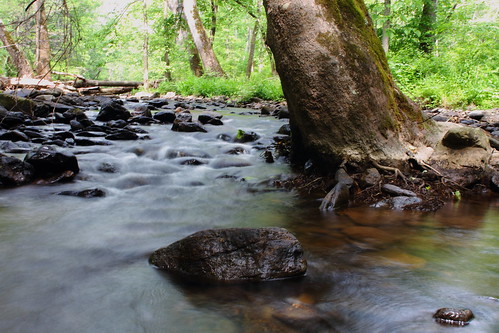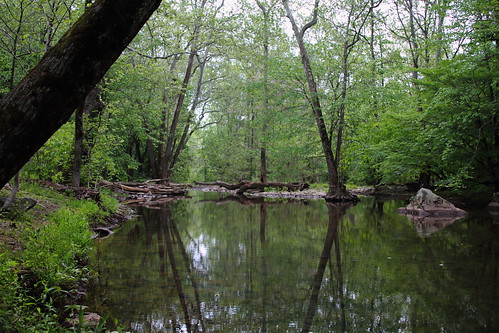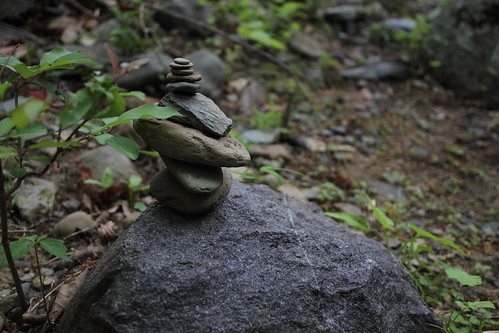Tuesday, September 27, 2011
Tuesday, June 01, 2010
Edit reel 2010
Once I finished this up I realized I had shot everything on it as well. The times, they are a-changing.
Sunday, May 16, 2010
Forget it Jake. It's... Chinatown

I spent this weekend at the D.C. studios of NPR in an amazing workshop on audio storytelling. I was excited - and appreciative of the good folks at the NAHJ and NPR who thought my body of work merited this growth opportunity, but I had no idea what I was in for when I rolled into the NPR parking garage at 8:30 on Saturday morning.
Leading the class, Sora, NPR's training director and and an amazing - and incredibly kind -instructor, started immediately with the anatomy of an NPR story: Character, Narration, Scenes, Ambience, and Actualities. My professional experience is equally divided between writing and editing, so while I felt immediately at home I could also tell that I would be learning more - a great deal more - than I had expected. After listening to a few quintessential NPR stories (driveway moment kind of stuff) we were asked to dissect the stories; break them down into the five elements and how they kept us, as listeners, engaged.
We talked about audience and the need for a clear sense of direction. Focus. Active Voice. The difference between writing for print and for The Ear. Our teachers shared an analysis and comparison on a particular story as it was reported in the New York Times, The Washington Post, and NPR. The print stories were multiple pages, with photos, graphics, and gave multiple takes on the event at hand. The radio version was, when presented in the same font size and column width, two columns and took up about half of an 8.5"x11" sheet of paper. You can always put down the paper and come back to it. If you decide to answer the phone when you're listening to the radio, the story is gone forever.
The truth is, I'm a wordy writer. Those last three paragraphs could have been boiled down to one. This, I think, was what I was really there to learn. Our assignment: listen to a pre-recorded interview with a local historian about the history of DC's Chinatown (where we were located), pick an element of that history, go get some interviews, and write your story. Sure, I picked up some great interview and writing techniques, but when we came back from our street interviews, I was torn; just as with my last "assignment", I was seeing stories everywhere, and in everything. I was trying to be artistic, poetic, and comprehensive all at the same time. The writing contained all the things I love to read and no one has the time or attention to listen to. One producer sat down next to me as I wrestled with my script, and in minutes half of it was gone. One thought per sentence. Active voice. What's the action? Leave space for... space.
Once my story was disemboweled, NPR anchor and all-around awesome person Lakshmi Singh stopped by to check on my progress. "What's it about?" I really couldn't say. I had my selected interviews, I had the bones of a story, and in a minute she distilled it for me - listening to my 60 seconds of interviews she saw what I couldn't see for the fog of trying to write what it was not.
We finished the day by turning in a file of our selected interview clips and reading our story live to the class, cueing Rolando, an NPR producer and one of our fantastic trainers, to play back our clips as we would have them appear on-air (complete with the anchor intro, which was a bit weird, as I had to introduce myself, but hey - we're there to learn how to do it when we really submit a story to them, so that's pretty cool). We were all given the same assignment, and the class came back with six wonderful and incredibly different stories of this neighborhood and the people who live in or pass through it. After I read my story to the class, wrapped the workshop and got back to the hotel, I had to keep working on it and hear it in (nearly) finished form, complete with the NPR logo I created in Logic. This is the finished, but rough, draft:
Monday, May 03, 2010
A Moment in May
Where will you be on Sunday, May 2, at 15:00 hours (U.T.C.)?
...asks the New York Times Lens. Here's where I was:

So... 11AM, wherever you happen to find or put yourself, with a camera. Sounds pretty simple and that’s really the trick – if it sounds simple then it usually isn’t, and that’s where the fun part kicks in. I decided to get out of my house and get out of my yard; the NYT guidance was that it could really be about anything in terms of theme, but since this was to be part of a “Timely Global Mosaic” I thought a sense of place was important, so that’s what I started going for. I spend most of my time at work capturing images of people (which I love), but this seemed like a good time to stretch.
The weird thing about constraints is that they make your mind work SO hard. Not hard as in difficult – hard as in overdrive. So here I was, no time to think and nothing but thoughts, which – doh! – was exactly why I undertook the challenge.
So with no time to think, I tested a few ideas that crept up on the bank.
Ah, so-so. It was just about the worst time of day to be doing this kind of thing. I stuck with my plan (it’s that first shot, up top). Wide lens, long exposure, moving water (and be in the water). I don’t think there’s anything earth-shattering about this shot but it has meaning in that I learned a lot while doing it. And after 11 O’clock hit I took a deep breath and a short walk and really enjoyed the day. Also, I think I won’t wear flip-flops the next time I try this sort of thing.
update: it made the cut!
...asks the New York Times Lens. Here's where I was:

... ankle-deep in the Moormans River during the height of snake and fly season.
I'm always looking for ways to hone my craft and this challenge seemed like a great opportunity/excuse to get off my couch and make a picture. I had about a day to think about what the shot ought to be, and how I might make it happen. Honestly, this is why I like “challenges” of this type – they force you to think a little bit and pull me out of the autopilot mode I find myself in at times.
I don’t know if going to your favorite place in the woods qualifies as a stretch, but I honestly had never done too much good shooting out there, aside from the video of my Dad, right after he fell into the river. I’d had some thoughts of wanting to make a picture from the middle of the creek, thinking it might give a neat perspective. Had it all planned out until I got in the car, with about :45 minutes until it was time to pull the shutter. That’s when the plan fell apart. It’s probably a ten-minute drive from my house to the location (less really) and I must have found 20-30 potential shots in those few short miles. The cemetery on the hillside. Weekend Harley warriors stopping for coffee at the country store. Fly fishermen heading toward the reservoir. Kids at the swimming hole. Flora. Fauna. Gah, make it stop!
The weird thing about constraints is that they make your mind work SO hard. Not hard as in difficult – hard as in overdrive. So here I was, no time to think and nothing but thoughts, which – doh! – was exactly why I undertook the challenge.
So with no time to think, I tested a few ideas that crept up on the bank.
Ah, so-so. It was just about the worst time of day to be doing this kind of thing. I stuck with my plan (it’s that first shot, up top). Wide lens, long exposure, moving water (and be in the water). I don’t think there’s anything earth-shattering about this shot but it has meaning in that I learned a lot while doing it. And after 11 O’clock hit I took a deep breath and a short walk and really enjoyed the day. Also, I think I won’t wear flip-flops the next time I try this sort of thing.
update: it made the cut!
Friday, April 02, 2010
5x5, in under 5
Love this idea, which I found via LonelySandwich, who quotes:
blakewhitman:
Do you ever shoot video with your point and shoot or iPhone and never do anything with it? Of course. Who has time, or the know-how, to edit a crazy involved video? It’s tedious and hard.
Not true! At Vimeo, we have a super simple project call ‘5 Vignettes’. It’s easy and a great solution for your lack-of-editing prowess. Take five, five second clips and string them together to make a twenty five second little video. Upload it to Vimeo and add it to the 5 Vignettes Group, or just go there and check out some examples. It’s really the best way to use up footage you never do anything with.
I will give away a free Plus Account to whoever reblogs this with the best 5 Vignettes video they make today by 11:59 pm PST. Older 5x5’s don’t count. Go!
this shows up at a good time for me, as I'm really trying to keep things moving by doing shorter, more fun projects that keep the creative juices flowing. As Sandwich writes:
I love this idea. I LOVE IT, THIS IDEA.
I edit for a living, and I hate it. It’s hard, it requires skill and competence to not do badly, and in the end, no one really notices unless you’re terrible at it. But we (you and I) have mounds and mounds of video that really is in some serious need of editing.
So apply some constraints, is what Vimeo is saying. Don’t get all fancy about it, just slam five good bits together.
This, like flickr’s “long photo”, might just be the cathartic reset that web video needs right now.
I’ll make a 5 Vignettes and post it later today. You should, too.
So I did, and here it is!
Tuesday, March 30, 2010
Thursday, March 18, 2010
Room for Innovation
(note - having some trouble getting this embed to fit, click here to see in full YouTube glory)
Commissioned to create a short doco/promo piece on a new space for teaching Innovation, I thought this would be the perfect time to bring my new HDSLR - the Canon 7D, in to play. There are a lot of workflow considerations to discuss and this piece is intercut with plenty of archival HDV b-roll and the occasional Panasonic AVCHD wide shot (the Panny was also the audio master for the piece), but the cinematic quality of the new cam provided production values higher than I ever expected, even though I've run a few jobs on this same platform with the Canon T1i, which I shot with strictly to get better low-light perfomance.
SO, can ya tell which shots we stretched on? Fun ;-)
Subscribe to:
Posts (Atom)

